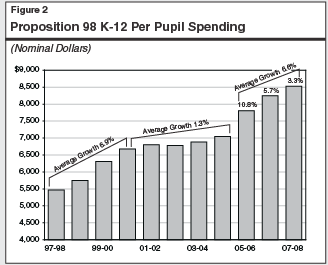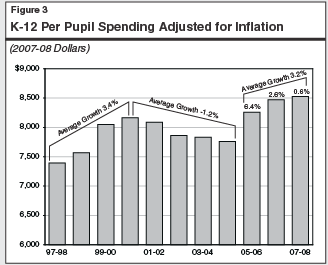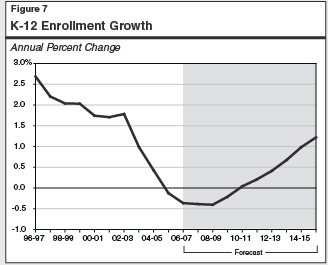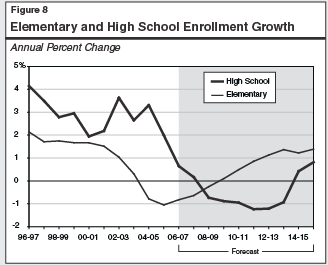Analysis of the 2007-08 Budget Bill: Education
The budget proposes to provide a $1.4 billion (2.9 percent) increase in K-12 Proposition 98 funding from the 2006-07 level. Schools would receive $8,524 per pupil—3.3 percent more than revised per-pupil expenditures in the current year. New funding is used primarily to provide a cost-of-living adjustment and increase the Proposition 98 share of the state’s child care program.
Figure 1 displays all significant funding sources for K-12 education for 2005-06 through 2007-08. As the figure shows, Proposition 98 funding constitutes over 70 percent of overall K-12 funding. Proposition 98 funding for K-12 education increases $1.4 billion (2.9 percent) from the 2006-07 level. This increase is supported mainly by local property taxes ($1.2 billion). Other funding for K-12 education increases by a combined $346 million (1.9 percent).
|
|
|
Figure 1
K-12 Education Budget Summary |
|
(Dollars in Millions) |
|
|
Actual 2005-06 |
Revised 2006-07 |
Proposed 2007-08 |
Changes From 2006-07 |
|
Amount |
Percent |
|
K-12 Proposition 98 |
|
|
|
|
|
|
State General Fund |
$34,582 |
$36,658 |
$36,851 |
$193 |
0.5% |
|
Local property tax revenue |
11,959 |
12,353 |
13,595 |
1,242 |
10.1 |
|
Subtotals |
($46,541) |
($49,011) |
($50,446)a |
($1,435) |
(2.9%) |
|
Other Funds |
|
|
|
|
|
|
General Fund |
|
|
|
|
|
|
Teacher retirement |
$999 |
$876 |
$966 |
$91 |
10.4% |
|
Bond payments |
1,681 |
1,857 |
2,201 |
345 |
18.6 |
|
Other programs |
160 |
554 |
413 |
-140 |
-25.4 |
|
State lottery funds |
1,036 |
1,012 |
1,012 |
— |
— |
|
Federal funds |
6,931 |
7,113 |
6,568 |
-545 |
-7.7 |
|
Other |
6,147 |
6,352 |
6,948 |
596 |
9.4 |
|
Subtotals |
($16,954) |
($17,763) |
($18,109) |
($346) |
(1.9%) |
|
Totals |
$63,495 |
$66,774 |
$68,555 |
$1,781 |
2.7% |
|
K-12 Proposition 98 |
|
|
|
|
|
|
Average daily attendance (ADA) |
5,964,108 |
5,940,989 |
5,917,948 |
-23,041 |
-0.4% |
|
Budget amount per ADA |
$7,803 |
$8,250 |
$8,524b |
$275 |
3.3% |
|
|
|
Totals may not add due to rounding. |
|
a Reflects
Governor's proposal to fund Home-to-School Transportation ($627
million) from the Public Transportation Account and rebench the
Proposition 98 guarantee downward by a like amount. If the swap were
not to occur, the change from
2006-07 would be $2.1 billion—a 4.2 percent increase. |
|
b Assumes
transportation funding swap. If swap were not to occur, the
per-pupil rate would be $8,631, reflecting a 4.6 percent increase
over 2006-07. |
|
|
Proposed School Transportation Funding Shift Affects Year-to-Year Comparisons. The budget proposes to shift the $627 million Home-to-School Transportation program out of Proposition 98—funding it instead from the Public Transportation Account (PTA). In a related action, it proposes to “rebench” the Proposition 98 minimum funding guarantee downward by a like amount. Because funding for the transportation program is included in the K-12 Proposition 98 totals in Figure 1 for 2006-07 but not for 2007-08, comparing the two amounts understates the actual year-to-year change in resources for K-12 education. If the $627 million shift were not to occur and the guarantee was not rebenched downward, total K-12 Proposition 98 funding would increase by $2.1 billion, or 4.2 percent, from 2006-07. Shifting funding for the transportation program to PTA also explains the notable increase in the “other” funds category ($596 million).
Federal Funding—Decrease of $545 Million. The largest decrease in non-Proposition 98 funding is due to a drop in federal funds. The Governor’s budget assumes a year-to-year decrease in federal funding of $545 million. About half of that reduction is due to the Governor’s proposal to reduce federal funding for child care and instead use the funds to cover other California Work Opportunities and Responsibility to Kids (CalWORKs) costs ($269 million). (In a related action, Proposition 98 support for child care would be increased by roughly the same amount.) Another sizable decline ($77 million) is related to an expected decline in caseload for Stage 2 child care. In addition to these child care-related reductions, the budget assumes considerable reductions in federal support for the Even Start program ($50 million) and 21st Century Learning Centers ($34 million).
Repaying Bonds for School Facilities—Increase of $345 Million. The bulk of this increase in debt service is due to recent investments the state has made in school facilities through Proposition 47 (2002) and Proposition 55 (2004). These measures authorized the state to sell a total of $21.4 billion in bonds for school facilities. Proposition 1D, approved by the voters in November 2006, authorized an additional $7.3 billion for school facilities. (Not reflected in Figure 1, and distinct from debt-service payments on already sold bonds, is the Governor’s proposed $6.9 billion in expenditures from yet unused prior-year bond monies as well as new bond monies available from Proposition 1D.)
Teachers’ Retirement Costs Increase by $91 Million. The Governor’s budget includes $966 million in 2007-08 for the state’s annual K-12 contribution to the California State Teachers’ Retirement System (CalSTRS). Year-to-year comparisons are complicated because of a one-time reduction in the state’s contribution in 2006-07. (The reduction is related to prior-year accounting errors that had resulted in overpayments.) Absent this factor, state contributions would have risen steadily since 2005-06 due to expansion of teacher payroll. The Governor’s budget for 2007-08, however, proposes to constrain costs by making a change in one of CalSTRS’ benefit programs. Thus, the $91 million increase from 2006-07 to 2007-08 is the net result of continued growth in teacher payroll offset by the proposed change.
Budget Continues Recent Growth Pattern, Increasing Per-Pupil Funding by $275. The Governor’s budget provides an additional $275 per pupil in Proposition 98 funding, a 3.3 percent increase from the current year. Figure 2 shows per-pupil spending levels over the last decade. The numbers are in “nominal” dollars—that is, not adjusted for inflation. The figure shows three distinct trends—a fast growth period in the late 1990s, a slow growth period between 2000-01 and 2004-05, and significant increases over the past three years (reflecting an average annual increase of 6.6 percent).

Even After Adjusting for Inflation, Per-Pupil Funding Has Experienced Healthy Increases in Recent Years. Figure 3 adjusts per-pupil spending for inflation. While K-12 spending still shows rapid growth in the late 1990s, between 2000-01 and 2004-05 it did not keep pace with rising costs (declining at an average annual rate of 1.2 percent). This trend began to change in 2005-06 with a substantial 6.4 percent increase over the previous year. The Governor’s proposal would grow adjusted per-pupil spending an additional 0.6 percent in 2007-08. Looking at changes over the last decade, spending (in inflation-adjusted terms) has increased by approximately $1,130 per pupil (15 percent).

Including Additional Funding Sources Raises Per-Pupil Totals. As discussed above, the Governor’s proposal to shift transportation funding out of Proposition 98 complicates year-to-year comparisons. These comparisons also are complicated by a settlement agreement related to Proposition 98 K-14 funding requirements (referred to as the California Teacher’s Association, or CTA, settlement). As a result of that seven-year, $2.8 billion settlement, schools in 2007-08 will receive an additional $268 million to use primarily for class size reduction (CSR) in grades 4-12. Figure 4 shows how per-pupil spending levels would increase if the transportation and settlement monies were included. Adjusting for the transportation funds, the Proposition 98 per-pupil funding would be $8,630, or $380 over 2006-07 levels. This equates to an increase of 4.6 percent in actual dollars, and an increase of 1.9 percent after adjusting for inflation. Were the CTA settlement funds to be included as well (roughly $45 per pupil), funding per pupil would be $8,675, an increase of $426 over 2006-07. This is an increase of 5.2 percent over the current year (2.4 percent adjusted for inflation).
|
|
|
Figure 4
Three Approaches to Calculating Proposition 98
K-12 Per-Pupil Spending |
|
Per Average Daily Attendance |
|
|
|
Change From 2006-07 Revised |
|
|
2007-08 |
Amount |
Percent (Nominal) |
Percent
(Adjusted) |
|
Governor's Budget |
$8,524 |
$275 |
3.3% |
0.6% |
|
Including transportation funding |
8,630 |
380 |
4.6 |
1.9 |
|
Including transportation and
settlement fundinga |
8,675 |
426 |
5.2 |
2.4 |
|
|
|
a The CTA settlement
provides $268 million to K-12 education in 2007-08. This equates to
around $45 per average daily attendance. |
|
|
Settlement Differs in Important Ways From Other “Settle-up” Funds. Typically, our per-pupil totals do not include one-time settle-up funds provided to meet a prior year’s Proposition 98 obligation. Because these funds are provided in one year and not the next, they skew year-to-year comparisons. Because the CTA settlement funds will be provided over a seven-year period and will fund items that are ongoing in nature—such as hiring teachers to reduce class sizes—we believe it is important to show how they affect per-pupil funding levels. (However, it is also important to note that these funds will be used to support only about 500,000 students at high per-pupil rates—$500 for each K-3 student, $900 for each grades 4 through 8 student, and $1,000 for each high school student.)
Figure 5 displays the major K-12 funding changes from the 2006-07 revised
budget. In 2007-08, the Governor’s budget proposes $1.4 billion in new
Proposition 98 K-12 expenditures for the following purposes:
-
Revenue Limits—$1.3 Billion. The Governor’s budget funds a 4 percent cost-of-living adjustment (COLA) ($1.4 billion) and captures savings from a decline in statewide attendance of 0.4 percent ($110 million savings).
-
Categorical Programs—$555 Million. The Governor fully funds all statutorily required COLAs for categorical programs and also provides COLAs for most other programs ($516 million). In addition, the budget captures savings from the 0.4 percent decline in attendance from roughly half of the categorical programs; it maintains approximately 25 programs at 2006-07 levels; and for the remaining programs, which have statutory growth rates different from the statewide rate, the budget provides applicable growth funding. The net effect of all attendance-related adjustments is an additional cost of $39 million.
-
Shift Home-to-School Transportation—$627 Million Savings. As noted above, the budget proposes to use PTA in lieu of Proposition 98 to fund the $627 million Home-to-School Transportation program. It also proposes to rebench the Proposition 98 guarantee downward, thereby reducing overall K-12 Proposition 98 funding by a like amount.
-
Increase Proposition 98 Share of Child Care Costs—$269 Million. In the current year, Proposition 98 funds support $1.4 billion of the state’s child care program. The remainder of program costs are supported through federal Temporary Assistance for Needy Families (TANF) and state General Fund monies. The budget proposes to shift an additional $269 million in costs—all for Stage 2 CalWORKs child care—from TANF to Proposition 98. This proposal is simply a shift in funding source and would not affect total monies available for child care, the level of child care services, or the Proposition 98 minimum guarantee.
|
|
|
Figure 5
Major K-12 Proposition 98 Changes |
|
(In Millions) |
|
|
|
|
2006-07 Revised K-12 Spending Level |
$49,010.9 |
|
Revenue Limit |
|
|
Cost-of-living adjustments (COLAs) |
$1,383.6 |
|
Decline in average daily attendance |
-110.4 |
|
PERS/UIa |
-6.1 |
|
Subtotal |
($1,267.2) |
|
Categorical Programs |
|
|
COLAs |
$515.7 |
|
Growth |
38.8 |
|
Shift Home-to-School Transportation |
-626.8 |
|
Shift child care Stage 2 |
269.0 |
|
Other |
-29.0 |
|
Subtotal |
($167.7) |
|
Total Changes |
$1,434.9 |
|
2007-08 Proposed |
$50,445.8 |
|
|
|
a Public
Employees' Retirement System/Unemployment Insurance. |
|
|
Figure 6 shows Proposition 98 spending for major K-12 programs. The budget provides $35.5 billion for revenue limits, which includes roughly $500 million for the state’s declining enrollment adjustment. (This adjustment allows districts to be funded at the greater of the current- or prior-year’s attendance level.) The budget also includes $3.5 billion for special education and $1.8 billion for K-3 CSR. The figure shows a significant increase in funding for child care ($358 million), although $269 million of this amount reflects the Governor’s proposed funding swap, not a net enhancement to the program. Similarly, the elimination of funding for Home-to-School Transportation reflects the proposed shift to PTA, not an elimination of state contributions for school transportation.
|
|
|
Figure 6
Major K-12 Education Programs
Funded by Proposition 98 |
|
(Dollars in Millions) |
|
|
Revised
2006-07a |
Proposed 2007-08a |
Change |
|
|
Amount |
Percent |
|
Revenue Limits |
|
|
|
|
|
General Fund |
$22,234.2 |
$22,303.6 |
$69.4 |
0.3% |
|
Local property tax |
11,949.6 |
13,147.8 |
1,198.2 |
10.0 |
|
Subtotals |
($34,183.8) |
($35,451.4) |
($1,267.6) |
(3.7%) |
|
Categorical Programs |
|
|
|
|
|
Special educationb |
$3,440.2 |
$3,513.4 |
$73.2 |
2.1% |
|
K-3 class size reduction |
1,763.5 |
1,820.7 |
57.2 |
3.2 |
|
Child care and development |
1,388.6 |
1,747.0 |
358.4c |
25.8 |
|
Targeted Instructional Improvement Block Grant |
1,034.1 |
1,071.7 |
37.6 |
3.6 |
|
Economic Impact Aid |
973.4 |
1,012.7 |
39.3 |
4.0 |
|
Adult education |
703.5 |
750.2 |
46.7 |
6.6 |
|
After School Education and Safety Program |
547.4 |
547.4 |
— |
— |
|
Regional Occupation Centers and Programsb |
486.4 |
514.2 |
27.7 |
5.7 |
|
School and Library Improvement Block Grant |
447.4 |
463.7 |
16.3 |
3.6 |
|
Summer school programs |
402.6 |
419.0 |
16.4 |
4.1 |
|
Instructional Materials Block Grant |
403.5 |
418.2 |
14.7 |
3.6 |
|
Deferred Maintenance |
269.9 |
276.3 |
6.4 |
2.4 |
|
Professional Development Block Grant |
264.1 |
273.7 |
9.6 |
3.6 |
|
Public School Accountability Act |
249.2 |
249.2 |
— |
0.0 |
|
Grades 7-12 counseling |
200.0 |
208.1 |
8.1 |
4.0 |
|
Home-to-School Transportation |
602.4 |
— |
-602.4d |
-100.0 |
|
Other |
1,591.2 |
1,649.2 |
58.0 |
3.6 |
|
Deferrals |
59.9 |
59.9 |
— |
— |
|
Subtotals |
($14,827.2) |
($14,994.5) |
($167.3 ) |
(1.1%) |
|
Totals—Governor’s Budget |
$49,010.9 |
$50,445.8 |
$1,434.9 |
2.9% |
|
|
|
a Amounts include
deferrals. |
|
b Includes both
General Fund and local property tax revenues. |
|
c Of this amount,
$269 million reflects the Governor's proposed funding swap rather
than an inflationary adjustment or a
programmatic enhancement. |
|
d Reflects proposed
funding shift from Proposition 98 to the Public Transportation
Account rather than a reduction in funding
or program elimination. |
|
|
Enrollment levels significantly shape the Legislature’s annual K-12 budget decisions. When enrollment levels increase slowly or decline, for example, fewer resources are needed to meet statutory funding obligations for revenue limits and categorical programs. This can leave more General Fund resources available for other budget priorities. Conversely, when enrollment grows rapidly (as it did in the 1990s), the state must dedicate a larger share of new resources to meeting statutory K-12 funding obligations. In light of the important implications of enrollment levels, we describe below two major trends in the K-12 student population.
The enrollment numbers used in this section are from the Department of Finance’s Demographic Research Unit and reflect aggregate, statewide enrollment. While the enrollment trends described here will likely differ from those in any given school district, they reflect the overall patterns the state is likely to see in the near future.
K-12 Enrollment Levels on the Decline. K-12 enrollment is projected to decline in 2007-08 for the third consecutive year—dropping by about 0.4 percent, for total enrollment of 6.2 million students. Figure 7 shows how enrollment growth has steadily slowed since the mid-1990s, with enrollment levels actually dropping since 2005-06. The figure also shows that K-12 enrollment is projected to continue declining until 2010-11.

Divergent Trends in Elementary and High School Enrollment. Figure 8 shows that the steady decline in K-12 enrollment growth masks two distinct trends in elementary (grades K-8) and high school (grades 9 through 12) enrollment. Elementary school enrollment growth has slowed since 1996-97, with actual declines in recent years. It is projected to begin growing again in 2009-10. In contrast, high school enrollment grew rapidly, from 1996-97 through 2004-05. Beginning in 2005-06, however, high school enrollment growth also began to slow. This trend is expected to continue, with actual declines projected beginning in 2008-09. Between 2007-08 and 2013-14, high school enrollment is projected to fall by almost 115,000 students.

Budget and Policy Implications. These enrollment trends have significant budgetary and policy implications for issues such as CSR, teacher demand, and facilities investments. Decreasing K-12 average daily attendance (ADA) also could lead to a significant change in future Proposition 98 requirements. Below we discuss a few of the major fiscal and policy implications.
-
In most years, the Proposition 98 minimum funding requirement—referred to as the minimum guarantee—is based partially on growth in K-12 attendance. Thus, as enrollment continues to decline, a smaller share of the state’s new revenues will be required for K-14 education. For the next few years, therefore, the Legislature will have the option of devoting a larger share of revenues to other budget priorities or else increasing per-pupil spending beyond what is required by the minimum guarantee. However, as discussed in the “Proposition 98 Update” section of this chapter, once the Test 1 component of Proposition 98 becomes operative, spending for K-14 education will be locked in at roughly 40 percent of the General Fund. As a result, the state will no longer experience savings from declines in enrollment.
-
Despite the general downward trend in enrollment growth, significant variation is expected to occur across counties. For example, over the next ten years, Los Angeles' enrollment is expected to decline by about 200,000 students (a 12 percent decline), whereas Riverside’s enrollment is expected to increase by about 140,000 students (a 34 percent increase).
-
Declining enrollment will likely affect the uses of new capital outlay bond funding. Fewer students indicate a decreasing statewide need for new construction dollars, and suggest that an increasing proportion of bond funding might be needed instead for modernization of existing school facilities. (Proposition 1D, approved in November 2006, allocates $1.9 billion for new construction and $3.3 billion for modernization. In contrast, the administration’s plan for 2008 and 2010 bond measures would provide $5.1 billion for new construction and $2.5 billion for modernization.)
-
The percent of Hispanic students will continue to increase. In 1995-96, 36 percent of the school-age population was Hispanic. By 2015-16, 48 percent will be Hispanic. Since many of these students will be English learners, the state will need to increase its focus on the language development skills of this group.
Return to Education Table of Contents,
2007-08 Budget Analysis